US Vaccine Rollout Surprisingly Good
As frustrating as it's been, we're ahead of just about every country.

Economist and Bloomberg opinion columnist Noah Smith points out that, while the United States’ vaccination rollout has been frustratingly slow, we’ve actually done better than just about any country on the planet.
The U.S. vaccine rollout is not going fast enough. Currently, about 1.7 million shots are being put into arms per day.
At that rate, according to the Bloomberg Vaccine Tracker, it will take 8 months to vaccinate 75% of the population (or essentially the entire adult population) with a two-dose vaccine. That’s not nearly fast enough, as more transmissible and antibody-resistant virus strains are spreading fast. Meanwhile we’re firing doctors for giving out vaccine doses out of order to prevent them from expiring, and we don’t even know how many doses the country is wasting. We need faster production and faster distribution. And we need a massive long-lasting upgrade of supply chains and distribution systems so we can quickly get booster shots into arms if and when a fully resistant strain emerges.
But. That said, it’s time to acknowledge a fact that few people seem to be acknowledging: The U.S. vaccine rollout, for all its faults, is ahead of almost every other country in the entire world. For those of us who were only recently wringing our hands about American decline, the fact of U.S. vaccine leadership provides a bracing counterexample and a reason to hope that the American system still retains a bit of the magic we were once taught to expect.
Here’s the data, sorted by doses delivered thus far per hundred people:
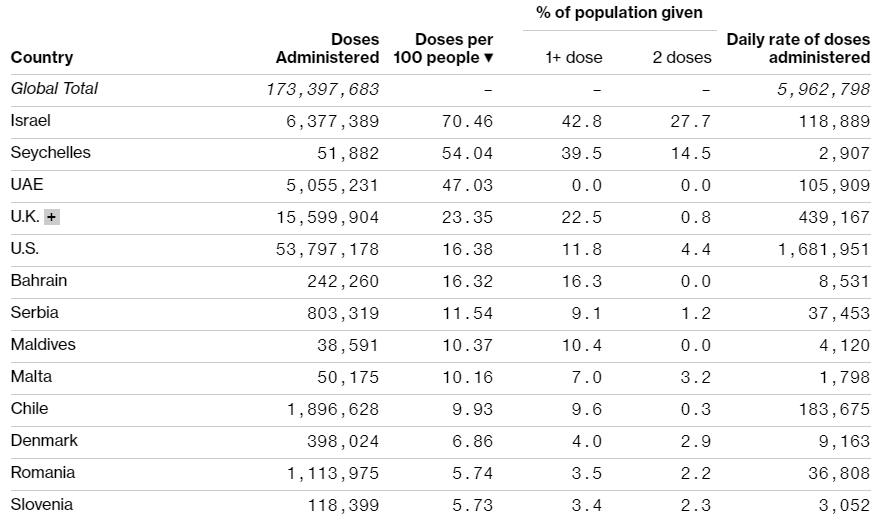
So, we’re behind three tiny countries and the UK which is in a unique position within the OECD because of the National Health Service. While probably inferior to other Western models in a lot of other ways, NHS has a decided network advantage in terms of distributing vaccines.
We’re not only ahead of every other developed nation in distributing vaccines but we’re ahead of even the UK in getting the most vulnerable populations the vital second dose. (In fairness, some other countries have made the determination that it’s better to get more first doses out. We’ll see how that plays out over time.)
It’s also worth noting that, as inept and mendacious as former President Trump was on managing this crisis and all the talk that President Biden had to start the process from scratch, the trendline has been rather steady:
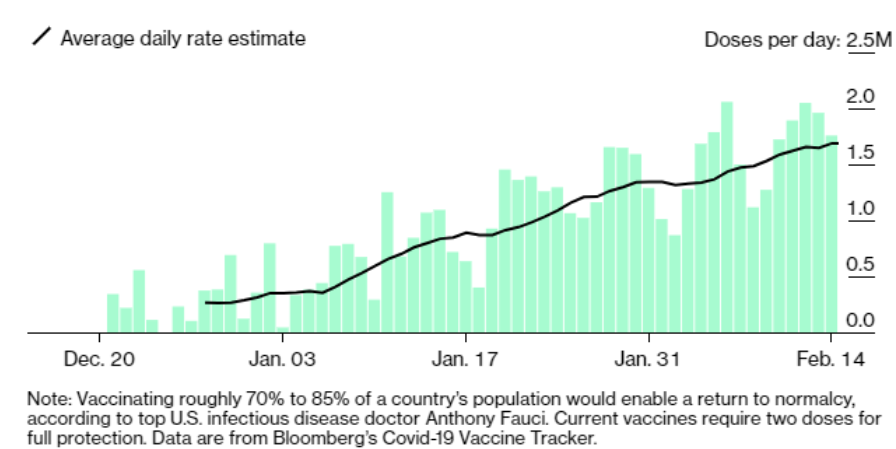
We’re only six weeks into the process, so we’ll see whether the US maintains this level of comparative performance.
One certainly hopes that Smith’s assumption that we’ll continue to hold steady at 1.7 million doses administered daily will prove pessimistic. We should, after all, expect us to keep getting better at manufacturing and distributing the vaccine for some time before plateauing.


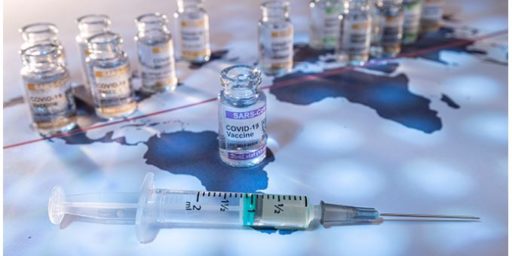
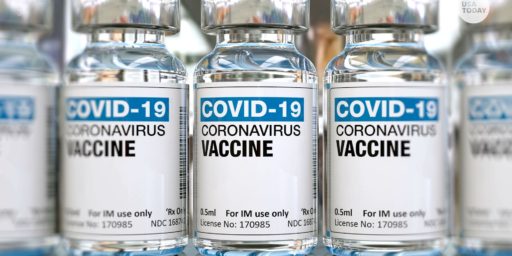
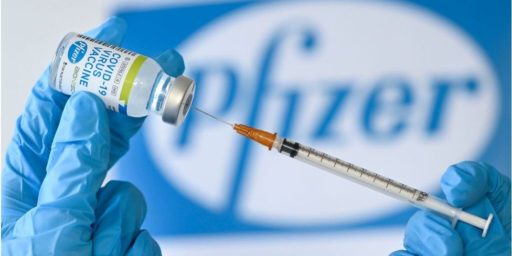
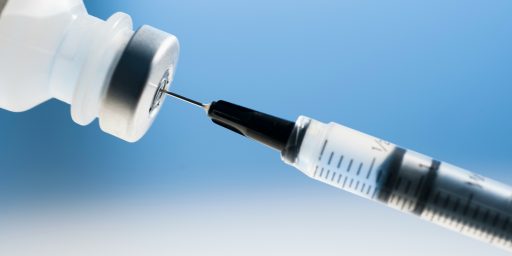
The numbers very much suggest that we are doing better than many perceive (myself included–and I have had a front-row seat to some of the distribution challenges at the state level).
I do think, however, that a more concerted effort, months ago, to start working with the states on this process would have produced substantially better results than even those that we are seeing.
@Steven L. Taylor:
That’s almost certainly right. If nothing else, as fantastic as Warp Speed seems to have been in getting the vaccines developed in record time, we way undershot purchase commitments and seemingly made no concerted effort at establishing the logistics for distribution. That latter, especially, should have been ironed out and wargamed months ahead of actual vaccine availability.
But it’s also true that we’re almost the opposite of the UK in being uniquely disadvantaged by sheer size, diversity, and lack of centralized control for distribution. It’s stunning that, even though Trump was at the helm during the crucial kickoff, we’re doing better than Denmark and Germany.
I know of several people in Mexico City who’ve gone to the US to get vaccinated. I’ve no idea how they manage it, other than to assume they don’t ask for Id or proof of residence or something.
Meantime Mexico is kind of trying to f**k everything up. Yesterday “mass” vaccination started, at a rate of one vaccine every ten minutes in some areas. They also began vaccinating people in rural areas, where transmission is lower than in urban areas. Waits of six hours are common.
@Kathy: My wife and I in FL have three shots so far and we’ve been asked for ID. However there’s no problem with out of state tourists getting shots here. In fact there’s a lot of complaining about it, but no restriction I’m aware of. Governor DeUseless was in town last week to make a big deal out of delivering doses to a gated community that’s largely snowbirds. In fact they cater to Canadians, although that’s way off due to travel restrictions. You just have to promise to be available in four weeks for the second shot. I’ve seen nothing specific to foreign tourists, but I suspect Mexican ID would be accepted.
@gVOR08:
Some have gone to Miami, a few to Las Vegas.
I may wind up doing that myself, if I can get my passport. My US visa is good until 2022.
I don’t know how much Warp Speed had to do with developing the vaccines. It has to have helped, but IIRC one of the prominent vaccines declined the money and other countries seem to have developed vaccines as quickly. Kathy (IIRC) noted one of the mRNA vaccine was designed in two weeks. I saw a mention a few days ago that it was two weeks a year ago, immediately after the Chinese released the gene sequencing of the virus.
But after Obama inherited W’s crash, I’m good with Biden taking credit for any fortuitous timing that falls his way.
We just bought 100M more doses of Moderna mRNA vaccine for delivery by 31 Jul.
For about $16.50/dose which seems very reasonable to me.
So, my initial suspicion that even if a vaccine came out in December that I’d not be likely to get it before July or August turned out to not be as far off as my doctor’s estimate that I might be getting it in February. Guess my claims of innumeracy are overstated. I’ll just chillax about it now.
In my household, my wife (a healthcare worker) has gotten both doses of Moderna, my 92 year old father in law has gotten dose #1 of Morderna, and I’ve gotten dose #1 of Moderna.
I mentioned in a previous thread how impressed I was at the efficiency of the vaccine centers. My wife went to a megaPOD, while my father in law and I went to two different Fire Department Vaccine centers. All three were run with military precision. And I’m talking “Full Metal Jacket” military precision, not “Stripes”.
Impressive all around, at least here in So. Cal. Our biggest issue is getting enough vaccines quickly enough. Several centers were too efficient. They gave away 6 weeks of vaccines in three weeks.
@gVOR08:
The Pfizer/BioNTech vaccine did not employ government funds, but it did take guaranteed advance purchase orders. BioNTech is a German firm, BTW.
Moderna claims two days for designing the vaccine, but that comes with a lot of unanswered questions and caveats. In any case, it had to go through preclinical and clinical testing, then into the common phases of testing. Given these last months, then the difference between 2 days and two weeks isn’t that big.
Also given the pace of manufacture and distribution makes the difference even smaller.
I’m sure neither China’s many pharmaceutical companies, nor Russia’s received any Warp Speed funds. Russia’s vaccine, according to a study published in The Lancet, seems only slightly less effective than the mRNA vaccines.
There remains many candidate vaccines in development, and the mRNA vaccines seem especially suited to quick redevelopment for emerging variants. So, it’s not as though anything Trump did was essential. Looking back, more focus on distribution and application might have been better.
But, seriously, the potential market for a COVID-19 vaccine is measured in billions. What company capable of coming up with a vaccine won’t try to develop one? It was also a given governments would buy the first billions of doses, too.
I see more merit in the countries that contained the virus quickly and effectively, who can now take their time with vaccines. After all, they don’t have a public health emergency anymore.
@James Joyner:
Unfortunately, this again highlights the challenge of Government Service Design within the US, where each State determines its own approach and infrastructure for distribution. That’s before we get to all the moving parts within a distribution (including how much vaccine is available at any given time and the logistics of moving it around).
Needless to say there a lot of moving parts to manage.
That said, as someone involved in Civic Service Design, it’s really frustrating to see how bad sign-up process is in many states, which adds undue to stress to an already complicated process. And those sorts of service design challenges are the thing that definitely could have been address months in advance.
Though don’t get me started on the BS article from the New York Times about how “Some dude built a better distribution site for $50” — just about everything within that site’s analysis was painfully wrong (and just advances the idea that throwing more tech at the issue will solve it).
Numerous sources globally were reporting that a vaccine was expected to be available starting in late 2020, and widely available by late Spring, early Summer 2021. Interesting (to me at least), it was such a political football in the U.S. that depending on who you talked to, there were completely different views on the pandemic itself, not just the vaccine.
In December of last year my wife and I watched a French series on Netflix called Plan Coeur (“The Hookup Plan” in English). It was the kind of kitschy romantic comedy that my wife enjoys watching, and I’m too cheap to get a second TV. It consisted of two seasons, released in 2018 and 2019 respectively, and there was intent to film a third season in 2020. Instead they filmed a single episode titled “The Lockdown Plan”, using masks and social distancing, and addressing issues everyone was facing. Significantly, at the end of the last episode everyone signs off with “We’ll all get together next April when the vaccine is widely available”. I’m looking forward to seeing how prescient the show was.
@Owen: I should have added, the last episode was released in France in August, 2020.
@mattbernius:
One other important point to bring up here (and I was just reminded about this on twitter) is that there really is no “off-the-shelf” enterprise IT platform for these sorts of things (especially given the hodgepodge of IT infrastructure that makes up each State’s systems). This means that any and every one of these types of projects is being built largely from scratch. Multiply that times at least 50 (one for each state) and you start to get the scope of the challenge.
@mattbernius:
If they’re talking about what I think, “a better distribution site” is completely wrong.
There was a programmer to tapped into available data and basically made a clearly-readable calendar showing open slots at all the vaccine centers. A link then took the reader to the appropriate page (on the official sites) to sign up for the slots.
On the one hand, all he did was make an easy-to-read page. On the other hand the fact that the official sites found that so difficult is somewhat telling.
@mattbernius:
Unfortunately, this again highlights the challenge of Government Service Design within the US, where each State determines its own approach and infrastructure for distribution. That’s before we get to all the moving parts within a distribution (including how much vaccine is available at any given time and the logistics of moving it around).
Honest question: Pharmaceutical companies already move large quantities of medicine to hospitals and clinics on a regular basis. Why can’t the information and experience of those logistics be scaled to vaccine delivery? It’s obviously not going to be a turn-key solution, but that should be able to handle a good portion of it, shouldn’t it?
@mattbernius:
My wife and I got our vaccinations through a local health system and they repurposed their training sign-up website to schedule the appointments, so when we got confirmation e-mails they read “Your Event/Class Registration” etc. And as I’ve commented here before, both my first and second vaccines took less than ten minutes from parking my car to getting the shot. It was exceptionally efficient.
From reading the many experiences of others in different counties and states, I am getting the distinct impression my area is a significant outlier and we are very fortunate.
@Steven L. Taylor:
@Kathy:
Oh, c’mon, everyone. Anyone with 4 working brain cells shouldn’t be surprised that The Orange One couldn’t/wouldn’t manage details on anything. He’s never met a detail in his life that held his interest for a nanosecond.
All credit to the scientists and laboratories that DID pay attention to the details, please.
@Mu Yixiao: What you describe is what the Safeway/Albertsons Pharmacy system that the DoH in Washington hitched onto in SW Washington to manage the mass vaccination center. The biggest problem is that there are no dates on the calendar, and starting tomorrow, the center will only be giving dose#2 until it has caught up.
The biggest bottleneck is still supply. Vancouver, WA is only the 8th or 9th largest city in the State and almost 45% of the total population lives in Metropolitan Seattle. Apportioning short supply in such a case is problematical at best. As I noted earlier, it seems like July or August is a reasonable expectation unless waaaaayyyy more vaccine comes online.
Still, a friend in Korea was just complaining 2 days ago how much he resents that Moon Jae-in is “dragging his feet” on starting vaccinations by waiting until they can get sufficient supplies to do something other than piecemeal vaccinations. (And I’m sure that my friend would be outraged that he wasn’t one of the *pieces* in the meal had Moon decided to go that way.)
@Mu Yixiao: The town that I moved across the river from has the largest regional medical center/hospital outside of forementioned Vancouver, WA. Itt is large enough to have a regional cancer center and Lifeflight service, and takes patients from 4 or 5 surrounding counties. My best understanding is that this facility has so far declined to take on vaccination until they can get sufficient supplies to begin scheduling their own clientele/patient rosters. It will indeed be a boon to vaccination in our county once that happens, but I think it’s a “when can it happen” rather than a “why didn’t we just.”
@Mikey:
Just out of curiosity, which state/county are you in? I’ve heard anecdotally about some places doing that, but don’t know the locations.
@Mu Yixiao:
That is what I was thinking of. Part of the problem with the “it just cost” $50 narrative was that (1) it was built on top of the existing data system and there was no accounting for the amount of personal time that was spent on the project (which was about 2 weeks of an expert tech person’s time which bills at a pretty high rate). Additionally, there was nothing about the need to be able to scale the local server (which I think was the guy’s laptop) to be able to accommodate load and reliability.
I do agree that the UX on these sites has been abysmal, which is really unfortunate given how many legitimate experts there are out there on improving the design of government forms.
@Just nutha ignint cracker:
Interesting.
Madison has had vaccines rolling out for a few weeks now. Mom (89) goes in for her 2nd jab on Friday. My sister and her husband have already gotten their first (he’s vulnerable, so they qualify).
The factory I work at has an RN on staff and doles out flu shots every year. They’re in talks with health officials to vaccinate our staff in-house (about 1,000 in two plants).
@mattbernius:
I didn’t read about it in the Times, and the approach was different. It never mentioned money, and said “two weeks of spare time”. The focus was more on the hassle and bad usability of the various state/county/etc sites and someone stepping up to give their own time to create something “better”.
@mattbernius:
Fairfax County, VA. Did our vaccinations through Inova. They’ve been great except for a temporary pause a couple weeks ago when vaccine supply was short.
In San Antonio, the LIMFAC has been supply as well as access to those of the other side of the digital divide. Other than that, it’s been pretty smooth. Get my second Moderna next Thursday. That is, if we recover smoothly from our weather disaster.
@Scott:
They decided the optics wouldn’t be good if they did it at Fort Detrick? 🙂
One thing I hope someone gets around to explaining is why convalescent plasma hasn’t worked.
Viral diseases are hard to treat. Once inside the body, you can’t kill the virus with drugs the way you can bacteria or parasites, you can only interfere with its ability to reproduce, or you can neutralize with antibodies (if we consider monoclonal antibodies a drug).
Convalescent plasma is blood plasma, with most cells filtered out, from patients who’ve recovered, and it should contain antibodies for the virus in question. That’s the theory. I don’t know if any other viral diseases have been successfully treated this way (I assume so).
Most people will produce antibodies, but this takes time. This is the reason immunity or protection arrive weeks after vaccination and not just after getting it (if it did, we’d have immunity right after infection anyway). They may arrive long after the virus causes irreparable damage, wither on its own or through the immune reaction it caused*. Therefore receiving antibodies to neutralize SARS-CoV-2 from plasma should help.
Of course, it must be far more complicated than that.
*Tom Clancy described chemotherapy more or less as “poison that kills cancer a bit faster than it kills the patient.” I’ve no idea how accurate this is, but something similar can be said of the reaction by the innate immune system (and parts of the adaptive one as well). One thing the immune system does is target infected cells. Once a cell gets virus inside of it, its like a hostile zombie that must be killed at any cost. Other defensive adaptations, like fever and inflammation, are generally damaging to your ells as well.
@DrDaveT: Well, the DEVCOM Chemical & Biological Center (which is the nation’s principal research and development center for non-medical chemical and biological defense) is based at Aberdeen Proving Ground so you have that.
@Kathy:
That’s pretty accurate.
I’ve heard a lot of stories of people who quit chemo because it was worse than the cancer. From an oncology nurse:
I remember sitting with my dad one day when he was in the middle of a course of chemo (radiation had failed). He kept fidgeting in his chair, like his shirt was scratchy or the chair was lumpy. And he had a sort of confused/annoyed look on his face. When I asked him what was wrong he replied “I… don’t feel good.”
I’m not sure, but I think I actually laughed. “Dad! You have cancer, and you had chemo yesterday! You’re allowed to actually feel bad.”
My dad was walking around on a broken hip that was riddled with cancer for a month and saying “I think I pulled a groin muscle in the woods”*. I’m a lot like my dad in that respect. Shit hurts? Deal with it**. When I hit 50 I started paying attention to things a little more. For my physical this past year, I took in a list of every little thing that was “wrong” and told my doctor (an old friend of the family) “Okay… I’m guessing 99% of this is ‘just getting old’, but you let me know.”
I was right. But… there’s that last 1% that’s actually wrong. Which is why I’m becoming really good friends with the nurses in the imaging department of the local hospital. 🙂
—-
* He was 85 and getting ready for deer hunting season
** Like Dad, I have a very high tolerance for pain, so most stuff “doesn’t hurt”.
@gVOR08:
When my wife and I got “jabbed” in Sarasota County Florida we had to:
1) show our out-of-state driver’s license
2) Prove (by way of a lease, minimum 90 days) that we are currently living in Florida
3) Show “official mail” (bank statement, credit card bill, etc) that we are receiving mail at a Florida address.
“It’s obviously not going to be a turn-key solution, but that should be able to handle a good portion of it, shouldn’t it?”
Part of it is the temperature requirements and lot sizes. Pfizer sends out large lots and requires very low temps. Moderna has smaller lots (more flexible) and you can use a regular freezer but they do have a pretty narrow temperature range so it is more difficult to manage. Besides that, as mentioned, supply is a real factor. Your local doctor’s office cant order some to keep on hand like they would a vaccine that is not in short supply. When I got my pneumococcal vaccine my PCP asked me if I wanted it and 2 minutes after she was done the nurse came in to vaccinate me. The vaccine didnt have any special handling requirements and you can just order it when you get low and receive it.
Steve
My wife and I both got the first dose two weeks ago. The local hospital is a machine, doing 800 a day at their peak until they literally ran out of vaccines to give. At the end of the day, they were calling local healthcare providers to come out to use up the remaining supplies.
I’m willing to give Trump some credit for this. Throwing money at Big Pharma seems to be the one thing he was good at.
We’re right to be dissatisfied. As it has been portrayed to us, we get the vaccine and the pandemic will be over. More realistic would have been “it will be over in a year”.
Compared to expectations our performance is completely inadequate. That it’s better than anyone else’s just confirms that we have unrealistic expectations.
My top concern with the low pace of vaccination isn’t so much how long it will be til I get a vaccine, but how much safer life will be when large numbers of people are vaccinated.
@Kathy: Now you’re sounding like me when I say that SARS CoV 2 (and it’s progeny) will be around forever and we’ll probably need annual vaccination.
@Just nutha ignint cracker:
I get a flu shot every year anyway, just stab me twice, I’m fine with it.
@Just nutha ignint cracker:
Forever is a long time.
I think it will be like the flu (at long last). Eventually. First we’ll need shot for the variants that are already out there. Then maybe anual shots for decades. By then it might not kill as many people, nor cause such bad symptoms.
@Kathy: At my age and general health, forever is probably about 10 years. Maybe 15, but I wouldn’t think so.